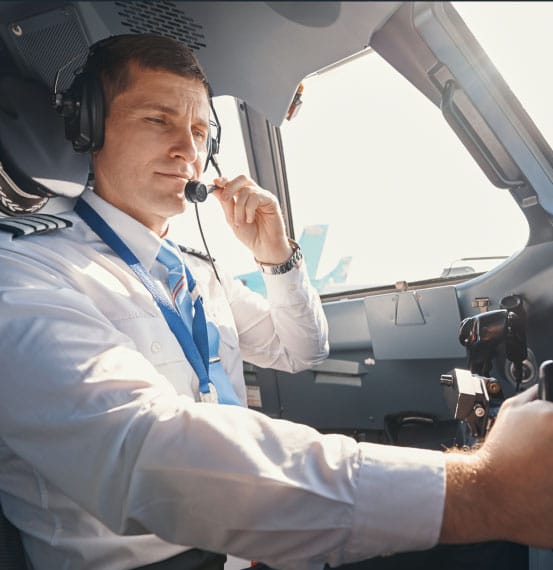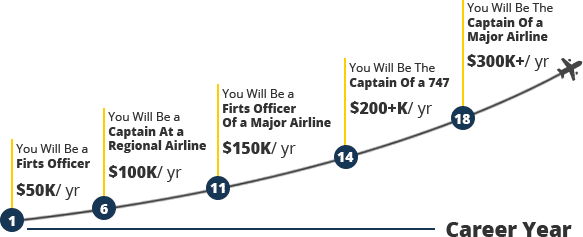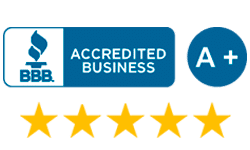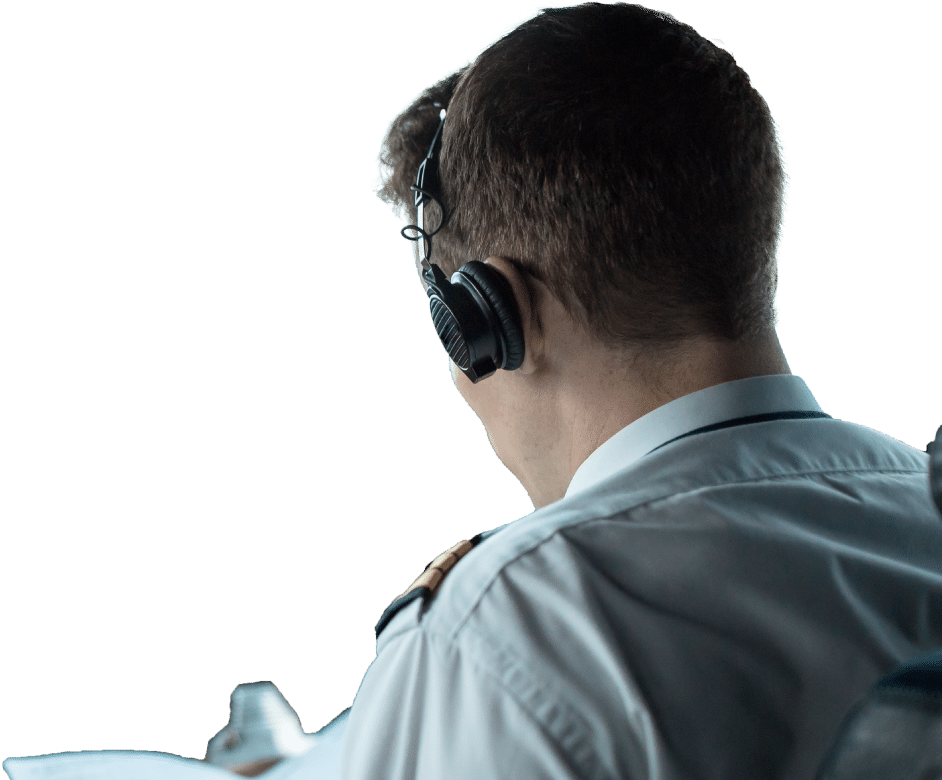
Commercial Pilot Certificate Training
Airline Career Flight Training in Arizona
You have accomplished a great deal by becoming a pilot! Your next goal is to ensure that you will be compensated for your professional training and abilities. The key to obtaining a commercial certificate is focusing your time and skill in order to develop a truly professional product. This will be done by attaining a number of flight hours, learning professional maneuvers and techniques. Once you have achieved this certification, the future of your career is now unlimited! As a commercial certified pilot you will qualify for such jobs as in flight instruction, aerial photography, banner towing, commercial airline flight, etc. Get started with Classic Air Aviation today!
Commercial Flight School Requirements
There are some requirements you must possess in accordance with 14 CFR 61.123. The requirements are as follow:

| Aircraft: Cessna 172M | $160 / hour | 15 Hours | $2,400 |
| Instructor | $75 / hour | 15 Hours | $1,125 |
| Ground | $75 / hour | 15 Hours | $1,125 |
| Total | $4,650 |
| Time Building | $160 / hour | 150 Hours | $24,000 |
| Total | $28,650 |
250 total time required at time of checkride
Arizona Airline Academy Reviews
Five Star Arizona Commercial Flight Training Facility
★★★★★
Marco Calcagno, Milan, Italy
★★★★★
Tyler H., Phoenix, Arizona
★★★★★
Phillip Gurbacki
Why choose to be a commercial pilot
You will climb to the top of the ladder with an annual salary of $300,000+ per year.
High demand, low offer
Boeing reports more than 617,000 Pilots are needed by 2035

Your experience really counts
Your salary not be determined by a hiring manager, This is what makes being a Pilot so superior. There is a seniority progression. And as long you execute your job, you will climb to the top of the ladder with an annual salary of $300,000+ per year.

“We’ve just hired 1,300 pilots this year. That trend will not stop for the next 10-15 years, there will continue to be a strong growth.”
Captain Kimball Stone, VP of Flight ![]()
Top-Rated Arizona Airline Pilot Flight School Near You
Leading Commercial Pilot Flight School in AZ
Because of the growing need for commercial airline pilots, now is the perfect time to enroll in an Arizona airline pilot training program! At Classic Air Aviation, we provide a fast-track commercial airline course that allows you to get your airline pilot license and pursue your dream in a matter of months! Using an immersive, detail oriented course structure and a streamlined curriculum, aspiring aviators can get the experience and knowledge they need to become a next generation commercial airline pilot. We offer affordable financing options, flexible schedules, and a one on one learning environment to help you take to the skies!





Earn Your Commercial Airline Pilot License In Arizona
Why Aspiring Commercial Pilots Choose Classic Air Aviation






Airline Career Path
From Zero Time To Certified Pilot In Nine Months
Private Pilots License
From Zero Time
What is a Private Pilot Rating?
The first step towards becoming a commercial pilot is earning your single-engine Private Pilot Certificate. Keeping your end goal in mind — ATP’s philosophy is to deliver airline-style training and flight experience at the very onset of a pilot’s training career. This is accomplished through standardized operating procedures and training students to a high level of proficiency. In your primary training stage you’ll learn the fundamentals of flight before moving on to cross-country and solo training. During this stage, all training is conducted in Cessna 172 moving-map GPS-equipped aircraft, or Piper Archers.
From a Student’s Perspective
Full immersion is an understatement. Two weeks into the program and I’ve done nothing but lived and breathed aviation – loving every minute. During the private pilot stage, my days start off with self-study, using ATP’s online learning modules. Here I’m learning all of the fundamentals of flying, which I’m confident is setting the foundation for the rest of my training. Mid-afternoon, I meet with my flight instructor for a preflight briefing and to go over a few questions I ran into during my self-study session. With questions answered and lesson objectives covered, I head out to preflight the aircraft at about 4pm. I’m excited for the flight ahead, as it is sure to be plenty full of stalls, slow-flight, ground reference maneuvers, and inevitably finishing with a round of landings.
What’s Included:
• Private Pilot iPad Home Study & Briefings
• Private Pilot Written Exam
• Single-Engine Flight Instruction
• Single-Engine Solo Flights
• Single-Engine Private Pilot Checkride
• Typical Training Day
Length:
How long does it take to get through your PPL training?


Instrument Rating
IR
What is a Instrument Rating?
Instrument rating is a pilot rating earned through intensive training and extensive flight practice hours. Through this course, pilots learn the art of navigating a plane through adverse weather conditions when they need to rely solely on instruments alone. Designed for pilots who already have their PPL, the IFR is an excellent addition to the repertoire and is a fun, challenging discipline of flight training. A well-trained and proficient pilot can successfully fly an airplane from Point A to Point B without ever needing to look out their window except for takeoff and landing.
From a Student’s Perspective
It will take a minimum of 40 hours of instrument time to obtain my instrument rating. Instrument time refers to the amount of time spent flying the plane while navigating solely with the instrument panel. Along with using an FAA approved simulator for some training sessions, I learn to fly the aircraft with a view-limiting device placed on my head so I can only see the instrument panel. After completing the practice hours with the instrument panel, I will study for my knowledge exam and prepare for the checkride with the instructor. I have been told it will take approximately 2-4 months to earn my instrument rating, depending on the type of program and how diligently I practice. The instrument rating is a key piece of my certifications, so I am ready to work hard!
What’s Included:
• Private Pilot iPad Home Study & Briefings
• Private Pilot Written Exam
• Single-Engine Flight Instruction
• Single-Engine Solo Flights
• Single-Engine Private Pilot Checkride
• Typical Training Day
Length:
How long does it take to get through your PPL training?


Your first solo occurs around 25 hours of flight with an instructor.
Commercial Pilots License
CPL
What is a Commercial Pilot License?
After earning your single-engine PPL, there are several steps to take before earning your commercial pilots license. Each airline-style training course and flight practice hour is designed with your ultimate goal in mind – to fly a commercial plane and its passengers safely from Point A to Point B. Through re-learning the fundamentals of operation, instrument rating, and solo flights cross-country, you will experience all aspects of aviation as you strive for your CPL. Classic Air Aviation will help you obtain ratings for every category and class of plane you wish to be paid to operate.
From a Student’s Perspective
Earning my Commercial Pilot License is the ultimate goal as I work through the various levels of airline training. Each day I spend several hours doing online learning modules to understand instrument ratings, flight patterns, terminology, and basic fundamentals in depth, along with a few hours of practice flights with my instructor. I will study for oral and written exams, and my checkride where I fly the plane essentially by myself under the supervision of the proctor to ensure I have fully earned the certification. At Classic Air Aviation, I know I am getting the highest quality training that will prepare me for the next level of certification. They are reliable, thorough, and even offer incredible financing assistance so that nothing can hold me back from my goal of being a commercial airline pilot.
What’s Included:
• Private Pilot iPad Home Study & Briefings
• Private Pilot Written Exam
• Single-Engine Flight Instruction
• Single-Engine Solo Flights
• Single-Engine Private Pilot Checkride
• Typical Training Day
Length:
How long does it take to get through your PPL training?


Your first solo occurs around 25 hours of flight with an instructor.
Commercial Multi-Engine Rating
MEI
What is a Commercial MEI?
Earning the Multi Engine Rating qualifies you to fly as a Pilot In Command (PIC) of any aircraft with more than one engine. Every aspiring commercial pilot is required to earn the MEI as they advance to commercial airlines and work to increase their overall marketability and qualifications in the aviation workforce. Through intensive training and extensive practice, you will ultimately be endorsed by the instructor for both flight and ground training along with a checkride to ensure your knowledge can be put into practice. The MEI is a valuable addition to any logbook.
From a Student’s Perspective
The commercial MEI course is simple and straightforward, and will qualify me to fly any commercial aircraft that has multiple engines. To start the course, I must have 10 hours of PIC in a multi-engine airplane. The commercial MEI course at Classic Air Aviation is typically 3 days of ground and flight training, followed by a checkride with a DPE on the 4th day. There is no written exam to prepare for! The commercial MEI course includes about 20 total hours of ground training and 6 hours of flight training, spread out over the course of 3 days. The training day will begin with 2 ground training sessions 3-4 hours each, and a flight schedule of 1-2 hours with the instructor, followed by a 3-4 hour session of self-study, video session, and research.
What’s Included:
• Private Pilot iPad Home Study & Briefings
• Private Pilot Written Exam
• Single-Engine Flight Instruction
• Single-Engine Solo Flights
• Single-Engine Private Pilot Checkride
• Typical Training Day
Length:
How long does it take to get through your PPL training?


Your first solo occurs around 25 hours of flight with an instructor.
Commercial Flight Instructor
CFI
What is a CFI?
A CFI course is designed to take a commercial pilot single or multi engine certificate holder to the completion of the certified flight instructor certificate. There is really no better way for all your aviation knowledge, practice, and training to take hold than to teach it to another student. The CFI course is ground heavy and covers all subject areas included in flight fundamentals and aeronautical knowledge. You will be brought back to the basics, spend many hours in self-study, and practice teaching other students under the supervision of your instructor.
From a Student’s Perspective
The CFI course structure is very hands-on and intensive, requiring hard work and dedication to ensure full certification. It is about 60-80 hours of groundwork and 10-12 hours of flight training, as the CFI qualifies you to teach comprehensive aviation both on the ground and in the air. The CFI course is ground-heavy as I will learn all subject areas in instruction fundamentals and aeronautical knowledge, while the flight portion teaches all private, commercial, and CFI maneuvers. By the end, I will be well-versed in spin awareness, entry and recovery techniques, along with all the confidence necessary to teach another pilot the same skills. My typical training day includes 2 ground sessions about 3-4 hours each, and a flight lesson about 1-2 hours long, followed by a few more hours of research, preparation, and self-study.
What’s Included:
• Private Pilot iPad Home Study & Briefings
• Private Pilot Written Exam
• Single-Engine Flight Instruction
• Single-Engine Solo Flights
• Single-Engine Private Pilot Checkride
• Typical Training Day
Length:
How long does it take to get through your PPL training?


Your first solo occurs around 25 hours of flight with an instructor.
CFI Instrument Rating
CFII
What is a CFII?
A CFII is necessary to provide instruction of the use of instruments for an instrument treating, commercial certificate, or ATP certificate. A CFI without the instrument rating is only allowed to provide training for instrument flying for a private certificate. Not only will your own skills be improved and challenged through the CFII course, but you will expand the knowledge and proficiency of your students by teaching them to safely fly in inclement meteorological conditions. You will also be authorized to endorse students taking both the FAA knowledge exam, oral exam, and practical test.
From a Student’s Perspective
Throughout the CFII course, we receive 15 hours of ground training, typically before and after each practice flight, where instrument instruction techniques are discussed along with how to prepare our students for their checkride. We also receive 15 hours of flight time training both through a simulator and under the hood, with the goal of total proficiency. Throughout my training course, my instructor provides multiple endorsements that allow me to take my FAA Knowledge Exam and Checkride with a Designated Pilot Examiner. Upon completion of the CFII course, I must pass the FAA Exam, the Instrument Oral Exam, and the Practical Test, each of which are designed to thoroughly test my abilities and instructional knowledge. Once all tests have been successfully completed, I will be awarded my Certified Flight Instructor Instrument Rating certificate.
What’s Included:
• Private Pilot iPad Home Study & Briefings
• Private Pilot Written Exam
• Single-Engine Flight Instruction
• Single-Engine Solo Flights
• Single-Engine Private Pilot Checkride
• Typical Training Day
Length:
How long does it take to get through your PPL training?


Your first solo occurs around 25 hours of flight with an instructor.
Multi-Engine Rating
MER
What is an MER?
If you wish to join an airline as a commercial pilot, the MER is an essential piece of your training. It adds multi-engine privileges to your existing private or commercial pilot license through flight training and ground school. The MER skills test can be completed after IR training, which allows you to gain more experience in handling the aircraft and covers the use of instruments on a multi-engine plane. Your training will include real-time flight hours, multi-engine simulator hours, and practical ground training as you learn to navigate the instruments in a multi-engine vehicle.
From a Student’s Perspective
In order to complete this course, I must meet the minimum requirement for flight hours and ground training. Once I have completed the MER, I will have experienced an oral and practical exam along with a checkride, and be qualified to act as PIC in a multi-engine aircraft under Visual or Instrument Flight rules. Most airlines will require me to carry my multi-MER with 25 hours of flight time in a multi-engine aircraft. My typical training day will include 2 ground sessions of a few hours each, followed by flight training about 1-2 hours. My day concludes with 3-4 more hours of self-study, research, and preparation for the following day. I know Classic Air Aviation is preparing me to be the best pilot, and each course is a valuable building block in that process.
What’s Included:
• Private Pilot iPad Home Study & Briefings
• Private Pilot Written Exam
• Single-Engine Flight Instruction
• Single-Engine Solo Flights
• Single-Engine Private Pilot Checkride
• Typical Training Day
Length:
How long does it take to get through your PPL training?


Your first solo occurs around 25 hours of flight with an instructor.
CFI TIMe BUILDING
CFIII
What is CFII Time Building?
Once you have successfully completed all the training courses necessary for your ATP, the last important piece is to build hours of flight time with a variety of aircraft. You are required to have 1500 flight hours in order to qualify for your ATP and commercial license, including both single-engine and multi-engine aircraft. Practicing your instrument rating, instructing others, and logging time both under the hood, in the simulator, and in real-life situations such as cross-country flights and solo flights, will all have a significant impact on your required hours.
From a Student’s Perspective
At this point in my training, I have completed essentially all of the certifications and courses required for gaining my ATP. I simply need to build flight hours and practice time to ensure I am adequately prepared to pursue a commercial airline pilot career. At Classic Air Aviation, I can rent a plane and practice flying cross-country, short flights, solo flights, and other skills. They offer a variety of combo packages to ensure I am making the most of my flight hours and gaining valuable experience while saving money. By combining my CFII, MEI, and 10 hours ME PIC together in one course, I will obtain better value for my multi-engine time, and be able to learn and practice instrument maneuvers and procedures in a variety of different aircraft types.
What’s Included:
• Private Pilot iPad Home Study & Briefings
• Private Pilot Written Exam
• Single-Engine Flight Instruction
• Single-Engine Solo Flights
• Single-Engine Private Pilot Checkride
• Typical Training Day
Length:
How long does it take to get through your PPL training?


Your first solo occurs around 25 hours of flight with an instructor.
Start Your Airline Career
atp
Where Do I Go From Here?
You’ve finally done it! After hours of researching and applying to the best pilot school, taking an introductory training flight, applying for an FAA medical certificate and student pilot certificate, taking your flight training lessons, passing the exams and checkrides, and achieving all the required certifications, and built your flight hours, you are finally ready to begin your career as a commercial airline pilot! Your next step is to polish your resume, ensure all your certifications and endorsements are in order, and begin applying to your dream job that you have worked so hard toward.
From a Student’s Perspective
Classic Air Aviation has helped me through every step of my training as I work toward my goal of becoming a commercial airline pilot. Through gaining my private license, a variety of ratings in different aircraft, my instrument rating for flying in adverse conditions, passing exams and checkrides, teaching other students, and finally building my flight hours, the career pilot program at Classic Air Aviation has pushed me toward success and challenged me every step of the way. I know my training has been invaluable, reliable, consistent, and the highest quality I could find anywhere in Arizona. Additionally, it has been completely affordable through the incredible financing options at Classic Air, and I could not have asked for a better training experience. I am ready to begin applying to commercial airlines and start my career!
What’s Included:
• Private Pilot iPad Home Study & Briefings
• Private Pilot Written Exam
• Single-Engine Flight Instruction
• Single-Engine Solo Flights
• Single-Engine Private Pilot Checkride
• Typical Training Day
Length:
How long does it take to get through your PPL training?


Your first solo occurs around 25 hours of flight with an instructor.
Time Building
Pilots typically need to build approximately 120 hours of flight time to be eligible for the commercial license after completing the private pilot license and instrument rating. Depending upon which aircraft is used for time building and how many hours a pilot needs for a total of 250 hours.
How Many Hours Do
You Still Need?
[CP_CALCULATED_FIELDS id=”1″]
Training The Next Generation Of AZCommercial Airline Pilots
Start Your Journey With Classic Air Aviation
Classic Air Aviation is a local Arizona flight school that is proud to help train the next generation of commercial airline pilots. Our immersive, in-depth commercial pilot training program offers a streamlined curriculum that allows pilots to get their license in as little as nine months, helping you start your journey in the sky as quickly as possible! The demand for professional, experienced commercial airline pilots will continue to increase, and were are here to meet those demands with our #1 Arizona pilot school! To learn more about our programs, contact us today or apply now!























